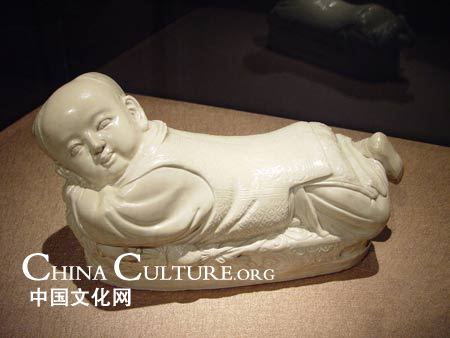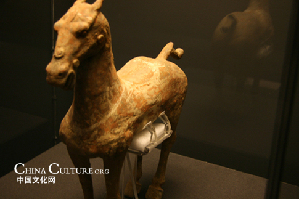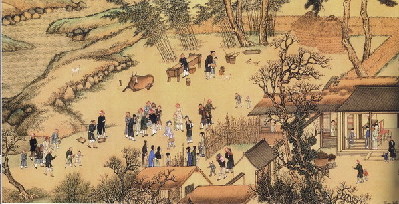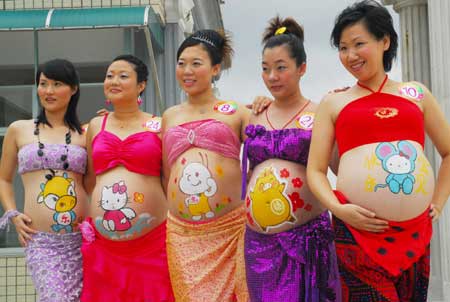| Home > Living in China > Art |
Dazu Rock Carvings
 In Dazu County, some 165 kilometers away from Chongqing , are more than 40 sites of stone carvings with over 50,000 statues of Buddha completed from the late Tang ?18-907)to the Song ?60-1279)dynasty. It is said that more than a thousand years ago, Buddhist and Taoist sects fiercely competed for ascendancy and imperial endorsement. As power changed hands and religious orders came in and out of favor, the victors would create new monuments to their gods and destroy the old ones. One result was that significantly harder materials were employed to build religious monuments, and the monuments got bigger. The monumental Dazu art testified to this trend.
In Dazu County, some 165 kilometers away from Chongqing , are more than 40 sites of stone carvings with over 50,000 statues of Buddha completed from the late Tang ?18-907)to the Song ?60-1279)dynasty. It is said that more than a thousand years ago, Buddhist and Taoist sects fiercely competed for ascendancy and imperial endorsement. As power changed hands and religious orders came in and out of favor, the victors would create new monuments to their gods and destroy the old ones. One result was that significantly harder materials were employed to build religious monuments, and the monuments got bigger. The monumental Dazu art testified to this trend.
The general term of "Dazu Rock Carvings" refers to all the cliff-side carvings in Beishan Mountain, Baoding Mountain, and so on.
It has been listed as a national relic under the state protection since 1961.In December 1999, it was listed as a world cultural heritage site by UNESCO.
The grottoes on the Beishan Mountain and Baoding Mountain are the largest in scale, richest in content and most refined in artistic skill.
Construction began on the Beishan Mountain in the late Tang Dynasty and lasted for more than 250 years, with some 300 niches containing some 10,000 statues of Buddha being carved. Although many of the statues have deteriorated over the centuries, there are a few that still remain in good conditions. Among the most notable is niche 136, which depicts a saint riding a white elephant and the goddess of mercy, Guanyin. The cave bearing the openwork octagonal "soul chariot" which symbolizes the eternal turning of the wheel of Buddhist law is the most fantastic piece of work. Right in the center of the cave is the statue of Sakyamuni, founder of Buddhism , which is flanked by more than 20 statues including the
 Buddha of wisdom and universal benevolence. Samantabhadra, or Bodhisattva of Universal Benevolence, was meticulously designed and executed with refined lines to give her a womanly image with graceful features, soft skin, gentle and tranquil expression and elegant posture. Her typical image of an Eastern beauty has won her the description as the "Venus of the East".
Buddha of wisdom and universal benevolence. Samantabhadra, or Bodhisattva of Universal Benevolence, was meticulously designed and executed with refined lines to give her a womanly image with graceful features, soft skin, gentle and tranquil expression and elegant posture. Her typical image of an Eastern beauty has won her the description as the "Venus of the East".Baoding Mountain
The carvings on Baoding Mountain, dating back over 800 years, is the largest and best preserved among the grottoes in Dazu. It includes almost 10,000 statues that formed a ritual site of Tantric Buddhism, a branch of Buddhism that disappeared 400 years ago in the north.
Many of the statues bear inscriptions that ask people to follow religious rules in their behaviors. Some statues are enlightening portraits that teach people to be have properly.
The Dazu Rock Carvings are remarkable for their aesthetic quality, their rich diversity of subject matter, both secular and religious, and the light that they shed on everyday life in China during this period. They provide outstanding evidence of the harmonious synthesis of Buddhism, Taoism and Confucianism.
Art
 more
moreClassic Chinese Handicraft:
Porcelain pillows, as classic Chinese handicraft,

Chinese Treasures Returned from
As witness of Chinese culture and custom, countless treasures

The lost legacy: classical music
Accompany by the long history of China, Chinese classical music

Customs
 more
moreChinese Kungfu
Kungfu Taste: Learn Martial Art in Shaolin Temple
The mention of Shaolin Temple conjures up images of a quiet and
Keet Kune Do will reappears on screen: BRUCE Lee and
The Legend of Bruce Lee is shot by China Central Television
The Road to the Olympic Games for Wushu
Wushu, also called kungfu, martial arts, is attracting more and more




 print
print  email
email  Favorite
Favorite  Transtlate
Transtlate 

